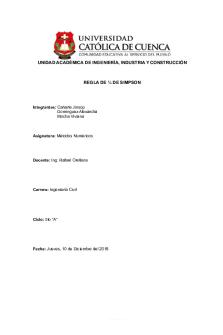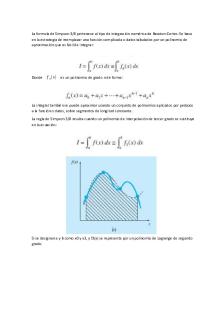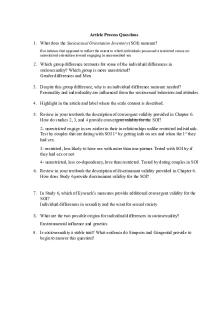Simpson Review - Professor Archias PDF

| Title | Simpson Review - Professor Archias |
|---|---|
| Course | Introduction To Art And Art History |
| Institution | University of Illinois at Chicago |
| Pages | 2 |
| File Size | 70.4 KB |
| File Type | |
| Total Downloads | 92 |
| Total Views | 195 |
Summary
Professor Archias...
Description
Guarded Conditions by Lorna Simpson (1989) Market Eye: Post Modern. Culture as the dominant value. One world that is ever-changing and becoming ever more complex (and thus unknowable) within the ever-same (and thus knowable) global marketplace. Formal Analysis ● ● ● ● ●
● ● ● ● ● ● ● ● ● ● ● ●
Title of work of art is purposely placed above polaroids African American female whose face is not shown to and whose back is facing us Access to the back of her head, the back of her body, her arms, part of her legs 3D Body that is fragmented Static, posed figure that is standing on a pedestal 18 polaroid prints, repetitive structure against opaque white background ○ Polaroids made of plastic ○ 91 x 131 inches Many details like clothing, lighting, skin color, hair etc., have a subtle change throughout each polaroid Arms folded behind her back, the right arm holding her left arm that has a clenched fist Display of photo texts: “SKIN ATTACKS” and “SEX ATTACKS” They are smaller in size, in capital letters, and on dark brown background Title is in all capitals above artwork Black woman whose back is turned to us with her arms behind her back. Colors are mainly neutral with little contrast. However there are exceptions Polaroid pictures are separated into their own individual frames Pictures are repeated 6 times One hand is in a fist the other is not Shadows get darker towards the bottom of each frame Each frame is not aligned with one another
Iconographical Analysis ● Body acts as a representation to the cruel repressions of history ● Simpson emphasizes the making of race and gender, and the violence exacted on the body to sustain these categories ○ “SKIN ATTACKS” and “SEX ATTACKS” determine the precarious social position on the black female ○ Photo texts symbolize multiple forms of domination that hold the body captive ● Simpson critique focuses on the bio-politics: the construction and naturalization of race as a biological fact and how the ways of subjection and domination fixate on the “biological body”
● Simpson rejects the primacy of the biological body as being used as an explanatory model for social relations ● Significance of disrupting the gaze by employing segmented bodies, anonymous figures, and serial images results: ○ Viewer’s curiosity being reflecting back onto his or herself ○ Reflection of how judgements are made, how women are evaluated and classified, the desires that are embedded onto a woman’s body, and the dynamics of spectatorship Phototexts emphasize how the dominant views of gender and race put black women into social standing with no security and predictability. Construction of naturalization and race as a biological fact has legitimated numerous instances of cruelty and brutality Iconographical Analysis Continued... ● More on significance of disrupting gaze: ○ Dominant economy of visibility crumbles because Simpson interrupts and refigures the politics of visuality ○ Destroying the visuality of economy fixes the meaning of race and gender ● Simpson’s representations of the female black bodies incorporate resistances and refusals to the dominant figurations of identity ● Political anatomy of the body is challenged because the figures defy our desires for conventional access with disrupting our gaze ● Refusal to reveal many details of the model mirrors the refusal of the world to know these black women ● Segmented bodies indicate the limits and failures of the representation in conveying black women’s experience, and point to the viewer’s failure to understand the figure ○ Simpson makes the viewer aware that the lives of black women exceed the dominant categories that judge and classify them ● The women are used to represent the treatment of women of color ● The image concentrates on the idea of women and race ● Provokes the viewer to self-reflect ● The image shows us how women are judged, viewed, and classified. Making the black woman general, makes them “universal figures”. Stands as an allegory for what it is like to be a person in postmodern times...
Similar Free PDFs

Michael Simpson
- 3 Pages

Metodo de simpson - Nota: 9
- 5 Pages

4.2.2. Metodo del Simpson
- 7 Pages

Taller Caso O.J Simpson
- 3 Pages

Desarrollo Simpson 3/8
- 3 Pages

CASO O. j. simpson
- 2 Pages

Review sheets 4-7 - professor nick
- 21 Pages
Popular Institutions
- Tinajero National High School - Annex
- Politeknik Caltex Riau
- Yokohama City University
- SGT University
- University of Al-Qadisiyah
- Divine Word College of Vigan
- Techniek College Rotterdam
- Universidade de Santiago
- Universiti Teknologi MARA Cawangan Johor Kampus Pasir Gudang
- Poltekkes Kemenkes Yogyakarta
- Baguio City National High School
- Colegio san marcos
- preparatoria uno
- Centro de Bachillerato Tecnológico Industrial y de Servicios No. 107
- Dalian Maritime University
- Quang Trung Secondary School
- Colegio Tecnológico en Informática
- Corporación Regional de Educación Superior
- Grupo CEDVA
- Dar Al Uloom University
- Centro de Estudios Preuniversitarios de la Universidad Nacional de Ingeniería
- 上智大学
- Aakash International School, Nuna Majara
- San Felipe Neri Catholic School
- Kang Chiao International School - New Taipei City
- Misamis Occidental National High School
- Institución Educativa Escuela Normal Juan Ladrilleros
- Kolehiyo ng Pantukan
- Batanes State College
- Instituto Continental
- Sekolah Menengah Kejuruan Kesehatan Kaltara (Tarakan)
- Colegio de La Inmaculada Concepcion - Cebu








